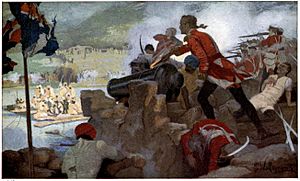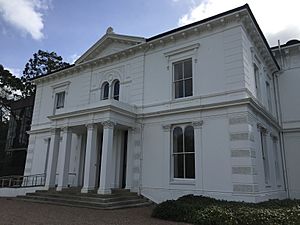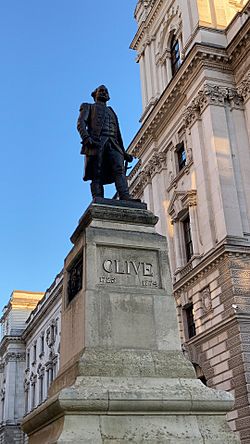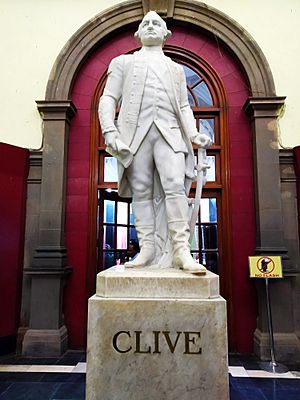Robert Clive facts for kids
Quick facts for kids
The Lord Clive
|
|
|---|---|

Lord Clive in military uniform. The Battle of Plassey is shown behind him.
By Nathaniel Dance. National Portrait Gallery, London. |
|
| Governor of the Presidency of Fort William | |
| In office 1757–1760 |
|
| Preceded by | Roger Drake as President |
| Succeeded by | Henry Vansittart |
| In office 1764–1767 |
|
| Preceded by | Henry Vansittart |
| Succeeded by | Harry Verelst |
| Personal details | |
| Born | 29 September 1725 Styche Hall, Market Drayton, Shropshire, England |
| Died | 22 November 1774 (aged 49) Berkeley Square, Westminster, London |
| Spouse |
Margaret Maskelyne
(m. 1753) |
| Children | 9, including Edward |
| Alma mater | Merchant Taylors' School |
| Nickname | Clive of India |
| Military service | |
| Branch/service | Bengal Army |
| Years of service | 1746–1774 |
| Rank | Major-general |
| Unit | British East India Company |
| Commands | Commander-in-Chief of India |
| Battles/wars | War of the Austrian Succession Battle of Madras Siege of Cuddalore Siege of Pondicherry Tanjore Expedition Second Carnatic War Siege of Trichinopoly Siege of Arcot Battle of Arnee Battle of Chingleput Seven Years' War Battle of Vijaydurg Recapture of Calcutta Battle of Chandannagar Battle of Plassey |
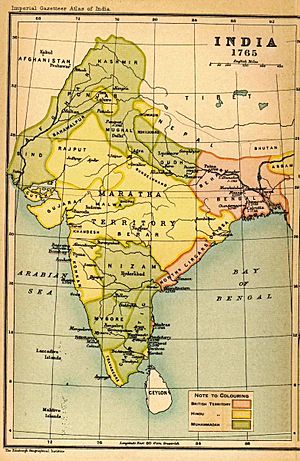
Robert Clive, 1st Baron Clive (1725–1774), also known as Clive of India, was a key figure in the history of the British East India Company. He is often credited with helping to establish British rule in Bengal, India.
Clive started his career in India in 1744 as a "writer," which was like an office clerk, for the East India Company (EIC). He became famous for his military leadership, especially after winning the Battle of Plassey in 1757. This victory helped the EIC gain control over Bengal, a very rich region.
Clive's actions in India have been debated by historians. He helped stop French influence in India and expanded the EIC's power. However, he also faced criticism for how he managed Bengal, especially concerning the Great Bengal famine of 1770. This famine caused many deaths.
Contents
Robert Clive's Early Life
Robert Clive was born on September 29, 1725, at Styche Hall in Shropshire, England. His family had a long history of public service. Robert was the oldest of thirteen children.

As a child, Clive was known for being a bit of a troublemaker. He was sent to live with his aunt in Manchester when he was very young. His aunt's husband described him as "out of measure addicted to fighting." He often got into trouble at school. There's a story that he once climbed the tower of St Mary's Parish Church in Market Drayton and sat on a gargoyle, scaring people below.
When he was nine, his aunt passed away, and he returned to Shropshire. He went to Market Drayton Grammar School and later to Merchant Taylors' School in London. His behavior continued to be unruly. Despite his early struggles in school, he later worked hard to improve his education. He became a skilled writer and speaker.
First Time in India (1744–1753)
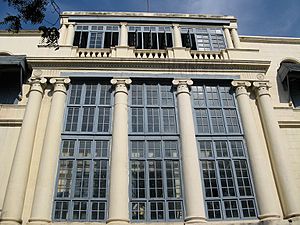
In 1744, Clive's father got him a job as a "factor" (company agent) for the East India Company. He sailed to India, but his ship was delayed for nine months in Brazil for repairs. This gave him time to learn some Portuguese.
Clive arrived at Fort St. George, near Madras (now Chennai), in June 1744. For two years, he worked as an assistant, managing books and dealing with suppliers. He also spent a lot of time reading in the governor's library.
India's Political Situation
When Clive arrived, India was made up of many states that had once been part of the Mughal Empire. The main rulers in the south were the Nizam of Hyderabad and the Nawab of the Carnatic. The British and French trading posts, like Fort St. George and Pondicherry, were in the Nawab's territory.
European countries like France, Britain, the Netherlands, and Portugal were all competing for trade in India. They built up their own armies to protect their business interests. Military power became very important for gaining control over valuable trade and land.
First Carnatic War
In 1744, Britain and France went to war in Europe, which also affected India. This conflict in India is known as the First Carnatic War. In 1746, French forces attacked and captured Madras from the British.
Clive and a few other British residents refused to promise not to fight the French. They managed to escape from the fort by disguising themselves. They made their way to Fort St. David, another British post. Clive decided to join the Company army, which was a brave step for him. He was recognized for his courage in defending Fort St. David and became an ensign (a junior officer).
During the 1748 Siege of Pondicherry, Clive showed great bravery in defending a trench. The war ended in 1748 with the Peace of Aix-la-Chapelle, and Madras was returned to the British.
Tanjore Expedition
Even after the war, fighting continued in India. Clive, now a lieutenant, joined an expedition to Tanjore. This mission faced many problems, but Clive again showed his bravery. He led a small force to attack a fort called Devikottai. His daring actions helped the British capture the fort.
Major Lawrence, Clive's commander, praised him, saying he "behaved in courage and in judgment much beyond what could be expected from his years." After this, Clive was given a job as a commissary, managing supplies at Fort St. George.
Second Carnatic War
The death of the Nizam of Hyderabad in 1748 led to a power struggle, known as the Second Carnatic War. The French Governor-General Dupleix saw this as a chance to expand French influence. He supported Chanda Sahib, who wanted to become the Nawab of the Carnatic.
The British supported Muhammed Ali Khan Wallajah, the son of the previous Nawab. The French and their allies gained a lot of power in southern India.
Siege of Arcot
In 1751, Chanda Sahib was besieging Muhammed Ali Khan Wallajah at Trichinopoly. The British were in a difficult spot. Clive offered to lead an attack on Arcot, Chanda Sahib's capital, hoping to draw him away from Trichinopoly.
Clive led a small force of 200 Europeans and 300 Indian soldiers (sepoys). They marched quickly and surprised the garrison at Arcot, taking the fort without a fight. The fort was old and large, making it hard to defend with so few men.
Chanda Sahib's son, Raza Sahib, soon arrived with a much larger army to besiege Clive at Arcot. Clive and his men worked hard to strengthen the defenses. They faced constant attacks and sniper fire. Clive was very resourceful, often making his small force seem larger than it was.
After a month, Raza Sahib launched a major attack on November 14. Clive's men bravely defended the fort, causing heavy losses to the attackers. The siege was a great victory for Clive.
His actions at Arcot made him famous in Europe. The British Prime Minister, William Pitt, called Clive a "heaven-born general." The East India Company rewarded him with a valuable sword.
In 1753, Clive married Margaret Maskelyne in Madras. They then returned to England.
Second Time in India (1755–1760)
In 1755, Clive returned to India as deputy governor of Fort St. David. He had been promoted to lieutenant-colonel in the British Army. He took part in the capture of the fortress of Gheriah, a stronghold of the Maratha Admiral Tuloji Angre. This battle was a clear victory for the British.
Calcutta's Fall and Recapture
In 1756, Siraj ud-Daulah became the new Nawab of Bengal. He attacked British settlements, including Calcutta, which he captured on June 20. Many British prisoners were held in a small, crowded cell, which became known as the "Black Hole of Calcutta." Many prisoners died there due to the terrible conditions.
By Christmas 1756, Admiral Charles Watson and Clive were sent to retake Calcutta. They quickly captured the fortress of Baj-Baj and then Calcutta itself in early 1757.
On February 5, 1757, Clive's small force faced the Nawab's huge army. Clive led his men through the Nawab's camp, under heavy fire. Although it wasn't a full military victory, this bold move intimidated the Nawab. He agreed to make peace and restore the East India Company's trading rights.
War with Siraj Ud Daulah
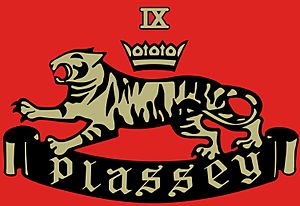
Britain and France were at war again, so Clive attacked the French colony of Chandannagar. The Nawab tried to help the French, but failed. Meanwhile, some of the Nawab's own officials, led by his commander-in-chief, Mir Jafar, secretly planned to remove him from power.
Clive made a secret agreement with Mir Jafar. Mir Jafar would become the new ruler of Bengal, and in return, he would pay a large sum of money to the East India Company and its British residents.
Battle of Plassey
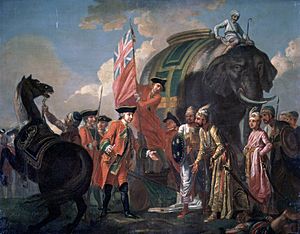
In June 1757, Clive marched his army towards Plassey, near the Nawab's capital. Clive had about 3,200 soldiers, while the Nawab had a much larger army of over 68,000 men.
On June 23, the battle began. However, there was very little actual fighting. The Nawab's gunpowder was damaged by rain. More importantly, Mir Jafar, who had secretly agreed to help Clive, led a large part of the Nawab's army away from the battle. This act of betrayal ensured the Nawab's defeat.
Clive's army suffered very few casualties. The Nawab, Siraj Ud Daulah, fled but was later captured and killed. Clive then made Mir Jafar the new Nawab of Bengal, as they had agreed.
Clive received a huge fortune for his role in the victory. The East India Company also gained significant revenue and control over Bengal. This battle was very important because it greatly increased British power in India.
Further Campaigns
Clive continued to expand British influence. He sent forces to defeat the French in other areas. He also dealt with the Mughal Emperor, Shah Alam II, who had tried to invade Bengal. Clive's forces defeated the Mughal army.
Dutch Aggression
The Dutch, seeing an opportunity, sent troops to their outpost at Chinsurah. Even though Britain and the Netherlands were not officially at war, Clive's forces, led by Colonel Francis Forde, defeated the Dutch in the Battle of Chinsurah in 1759.
Clive also worked to improve the East India Company's army, training Indian soldiers (sepoys) in European style. He strengthened Calcutta's defenses. In 1760, due to poor health, Clive returned to England.
The victory at Plassey led to the East India Company demanding a lot of money from Bengal. This put a heavy burden on the local people and led to widespread corruption among company officials.
Return to Great Britain
Clive returned to Britain in 1760 with a large fortune. He supported his family and helped his former commander, Major Lawrence. He was well-received and given the title Baron Clive of Plassey. He also became a Member of Parliament for Shrewsbury.
Clive tried to reform the East India Company's system in Britain. He argued with Laurence Sulivan, the chairman of the company's directors. News of problems in Bengal, including corruption and a rebellion by Mir Jafar's successor, forced the company to send Clive back to India.
Third Time in India
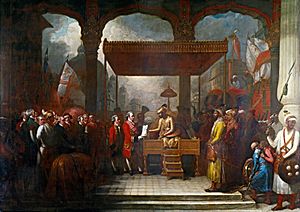
Clive arrived back in India in April 1765. He learned that Mir Jafar had died and that another battle, the Battle of Buxar, had taken place. A mutiny in the Bengal army was quickly put down. The Mughal Emperor, Shah Alam II, separated himself from the alliance against the British.
Clive had a chance to take more territory in northern India. However, he decided to focus on managing the rich region of Bengal. He returned some territory to the Awadh viceroy and gave other lands to the Mughal Emperor.
Mughal Decree (Firman)
In return, Clive obtained a very important document from the Mughal Emperor on August 12, 1765. This document, called a "firman," officially granted the East India Company the right to collect taxes (diwani rights) in Bengal, Bihar, and Odisha. This made the company the true rulers of millions of people and gave them a huge income.
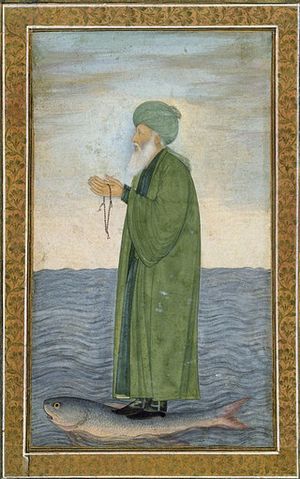
Clive also secured other important charters for the company's possessions in southern India. Even though the British presence in India was still small, these documents gave them great power.
Administrative Reforms
Clive tried to create a strong administration. He increased the salaries of company officials and banned them from accepting gifts from Indians. He also tried to stop their involvement in private trade. However, corruption remained a big problem.
His military reforms were more successful. He reorganized the army into three brigades, each strong enough to face any Indian army.
Clive also introduced a "Dual System of Government." The company handled revenue collection, while the Nawab was responsible for law and order. This system caused problems for Bengal's administration and was later changed.
Retirement and Death
Clive left India for the last time in February 1767. He bought a large estate called Claremont in England and had its gardens and house redesigned.
In 1772, the British Parliament began an inquiry into the East India Company's practices in India. Clive's political rivals used these hearings to attack him. When questioned about the large sums of money he had received, Clive defended himself, saying he had shown "moderation" given the opportunities for greater wealth. He was cleared of any wrongdoing.
A terrible famine occurred in Bengal between 1769 and 1773, killing many people. Some argued that the company officials' actions and greed contributed to this disaster. These events reduced Clive's popularity.
Clive continued to be involved in discussions about company reforms in Parliament. He defended his actions, stating, "Take my fortune, but save my honour." Parliament eventually passed the Regulating Act of 1773, which brought significant changes to the East India Company.
Robert Clive died on November 22, 1774, at the age of 49. He was buried in St Margaret's Parish Church in Moreton Say, Shropshire.
Clive was given an Irish peerage in 1762, becoming Baron Clive of Plassey. He bought land in Ireland and named part of it Plassey. Today, the University of Limerick stands on these lands.
Family Life
Robert Clive married Margaret Maskelyne in Madras on February 18, 1753. They had nine children, including Edward Clive, who later became the 1st Earl of Powis.
Historical Discussions
Clive's actions and legacy are still discussed by historians today. Some criticize his role in the Great Bengal famine of 1770 and his economic policies, which they say increased poverty in Bengal.
In recent years, some schools and public places named after Clive have been renamed due to these criticisms. For example, Clive House at Merchant Taylors' School was renamed "Raphael House." There have also been calls to remove statues of Clive in places like Shrewsbury and London, though many remain.
Legacy and Remembrance

- Robert Clive's old desk from Market Drayton Grammar School is on display at the local museum.
- A very old Aldabra giant tortoise named "Adwaita," believed to have belonged to Clive, died in the Kolkata zoo in 2006.
- Statues of Clive stand in Shrewsbury Square and in King Charles Street, London. There is also one in the Victoria Memorial in Kolkata, India.
- A house at the Duke of York's Royal Military School is named after Clive.
- Clive Road in West Dulwich, London, is named in his honor.
- A settlement in New Zealand's Hawke's Bay province is named Clive.
- Clive's family coat of arms can be seen at Claremont, a country house he rebuilt in Surrey.
- The children's novel With Clive in India (1884) by G. A. Henty tells the story of Clive's life.
- There was a stage play and a 1935 film called Clive of India.
- "Clive of India" is also a brand of curry powder in Australia.
- The poet Robert Browning wrote a poem about Clive in 1880.
See also
 In Spanish: Robert Clive para niños
In Spanish: Robert Clive para niños



